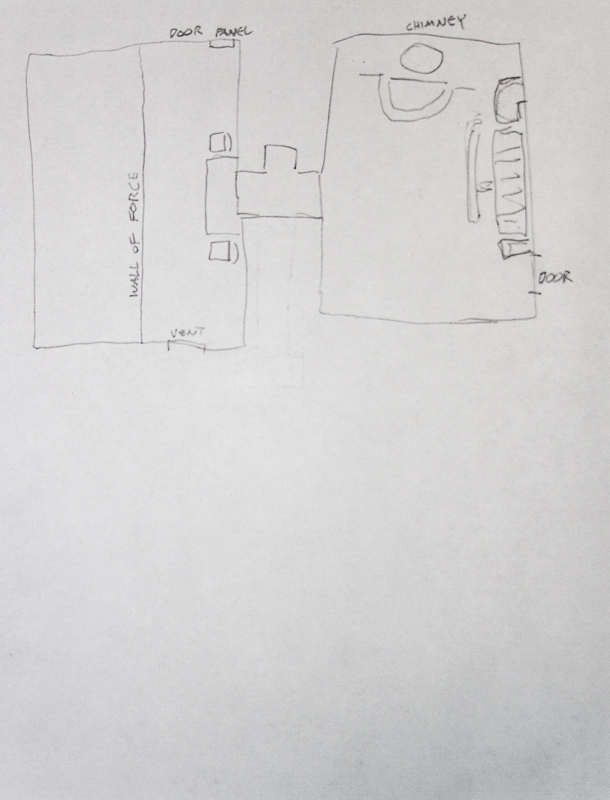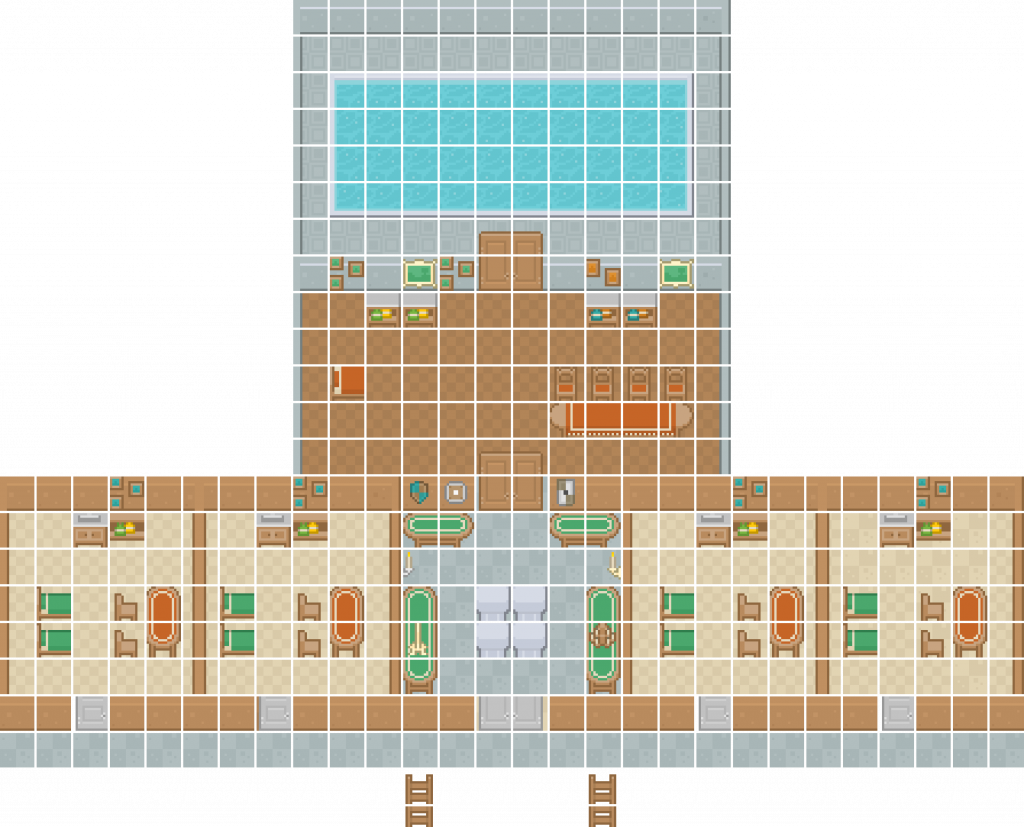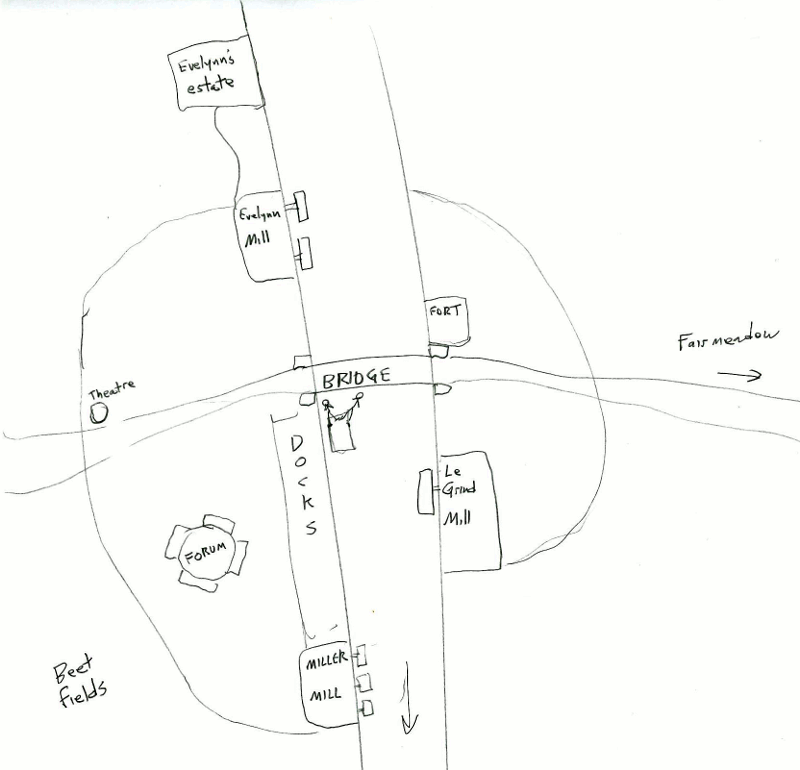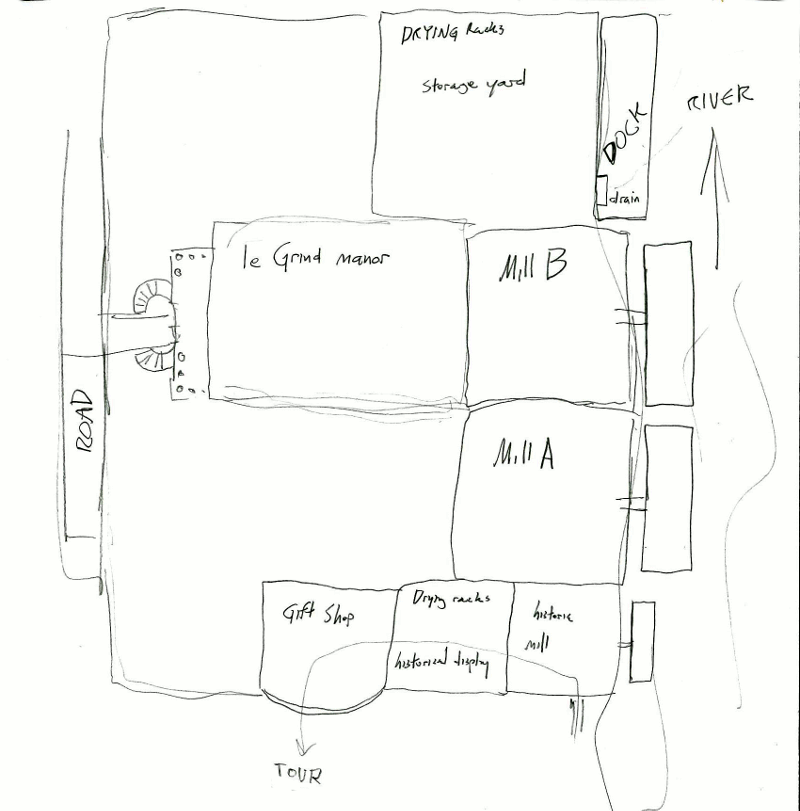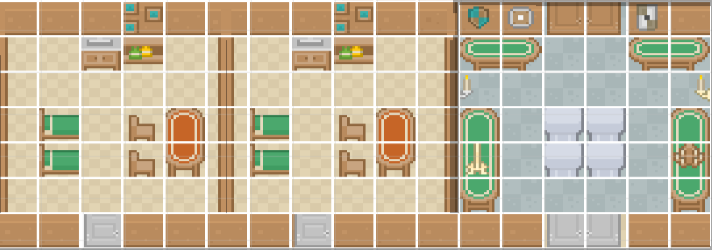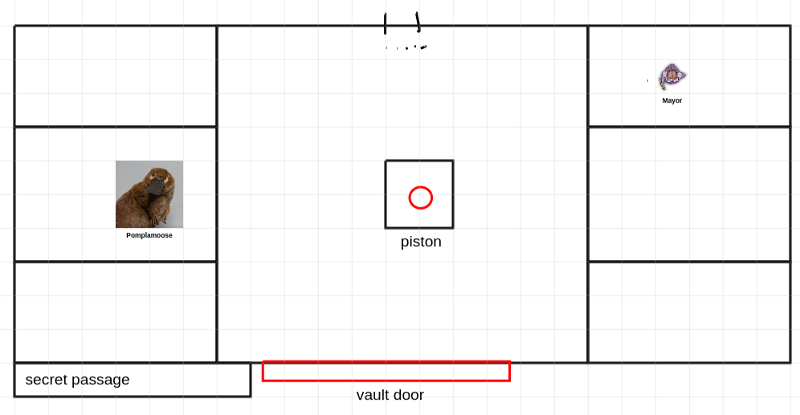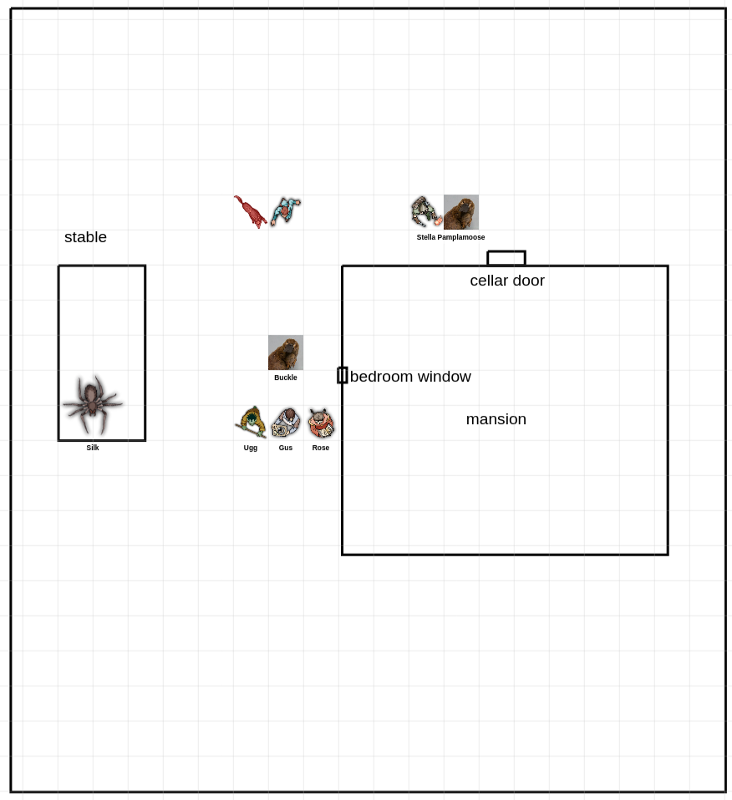GM note: This was the first time playing Blades In The Dark for all of us. Explaining the rules, creating characters, and creating the crew took two hours of a three hour time-slot. Since this game is much rougher than my “PG-rated family adventure” game of Fellowship, I started with Lines and Veils, a way to agree on what content to avoid.
In the Crow’s Foot district, a haunted jumble of ramshackle buildings and competing gang claims, stands a two-storey building with a small courtyard in the rear. Facing the street is a small store-front, the Ankhayat Repair Shop. It’s a front, of course. Actually two fronts. The Ankhayat’s actual family business is fixing people, not vehicles or appliances. Vond, the daughter with an unfortunate affinity for destruction, has recently started a new venture with a couple of friends.
The fountain in the courtyard hasn’t worked for years. Removing a flagstone from the empty fountain reveals a hole, which leads to a stair, which leads to a sewer, which leads to the canal. In this sewer is this hidden lair of the Goatriders, a strange crew of smugglers.
Goatriders
Strange Smugglers working out of Crow’s foot, traveling up and down the central canal, from Coalridge to Brightstone.
- Hidden lair (in the sewer beneath a broken fountain)
- Prowess training
- Smuggler’s rigging
- Vehicle: a small boat
Junker the Leech
Vond Ankhayat, daughter of immigrants from the Dagger Isles. She works at the family business as a clerk, since she’s too good at breaking things for a repair business.
Moth the Lurk
Myron Blackfield, an ‘ambiguous little dirty fae baby-faced troublemaker.’ She comes from a military family. She rejected the discipline and duty to slink around from party to party.
Skellington The Whisper
Yurei Kazokuai, from far-off Tycheros, has such pale skin that he could be mistaken for the ghosts he spends so much time around. He ‘looks like a tall Timothy Chalamet but paler.’ He used to work for the Spirit Wardens, but he’s fond of ghosts and doesn’t want to see them destroyed.
Contacts
- Eckard: Junker’s nemesis, a corpse thief who tries to rob Junker’s family business.
- Flint: Skellington’s nemesis, a spirit trafficker who tries to snatch the spirits that Skellington befriends
- Jul: Junker’s friend, a blood dealer who buys supply from Junker’s family business, both from corpses and from living donors.
- Rolan: a drug dealer for the Red Sashes
- Roslyn Kellis: really mad at Moth for neglecting to mention that she wasn’t nobility for the duration of their three-month whirlwind romance.
- Scurlock: Skellington’s friend, a vampire that Skellington is emotionally attached to.
- Telda: Moth’s buddy, a begger who infiltrates parties with Moth, and gives her crash space after she’s ejected from parties.
The story
Tensions are high in Crow’s Foot. The Crows keep the peace between other rival gangs, but the leader of the Crows died suddenly, and the smaller gangs are testing the limits of the new leader. The two main contenders are the Lampblacks, who don’t like the Goatriders, and the Red Sashes, who are fond of them. The Crows themselves think the Goatriders are a nuisance, but our fledgling crew does stay on the good side of the Gondoliers, who control the waterways they use for their smuggling.
Rolan, the Goatrider’s contact in the Red Sashes, tells them about a job. A shipment of drugs has arrived on The Docks, but Lampblacks are watching the docks and hassling the Red Sashes’ regular couriers. Since the Goatriders aren’t officially affiliated, Rolan wants them to pick up the shipment and deliver it to Rolan’s drug den in Crow’s Foot.
A spokesman for the Lampblacks walks into Ankhayet’s Repair Shop and says that big changes are coming to Crow’s Foot and that he wants to be sure they are on the right side. Junker is manning the front desk, and says she doesn’t know what he means, since they are humble junk dealers are tinkerers. The Lampblack knows they are a front (he probably doesn’t know that it’s two fronts) so he insists. Junker says that they want to be on good terms with everyone. The spokeman nods in mock understanding. He offers another job, one of goodwill. He has a gift for the Red Sashes, but it’s a surprise, and if Junker and her friends could slip it into the Red Sashes’ headquarters, that would be just great. Junker says she’ll think about it.
The Goatriders don’t trust the Lampblacks at all, and Rolan’s job plays to their strengths, so they choose the drug smuggling score. They will transport the packages via boat down the canal to Crow’s Foot, then carry them by hand the few blocks from the water to Rolan’s den.
engagement roll: 1d, 3, desperate
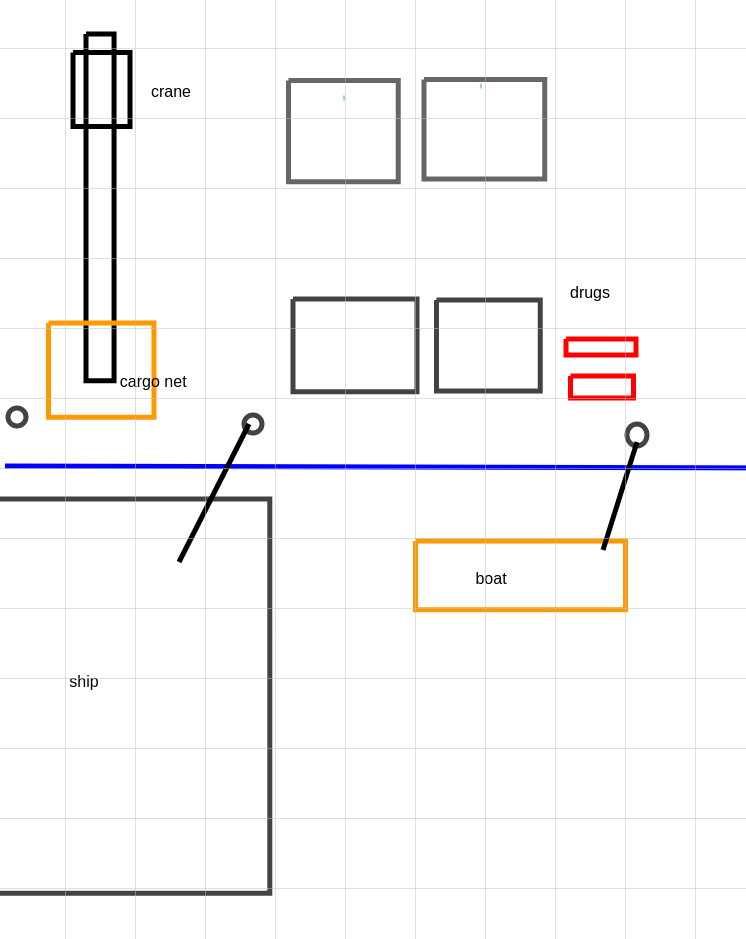
Junker pulls the boat alongside the dock that Rolan indicated. Moth and Skellington climb up to the dock (it’s built for big ships, not their small boat) and approach the two crates, about 100cm x 50cm x 50cm. Four Lampblack thugs approach. They aren’t just looking for Red Sashes, they are watching the crates themselves! “You can’t take those creates.” says the lead thug. “Those are ours.” Skellington & Moth feign surprise. Surely there’s been some mix-up. Their boss gave clear instructions. They try to get the thugs talking.
Skellington + Moth assist. Sway 2d desperate standard 5
These thugs were picked for their fists not their mouths, so they admit that they don’t really own these packages, but were told to prevent anyone from taking them. But two thugs circle around & separate the Goatriders on the dock from their companion on the boat. Junker maneuvers the small boat under the high dock and pulls out a crowbar to destroy the dock under those two flanking Lampblacks. They aren’t paying attention to her, but the dock is quite sturdy.
Junker Wreck 1d risky limited 6
Junker quietly pulls out the nails securing a few boards, then smashes one of the boards. The board doesn’t break away cleanly, so the thugs fall halfway through the floor and start struggling among splintered boards. The other two thugs roughly shove past Moth and Skellington to assist their teammates. Skellington tries to pick up a crate, but it’s surprisingly heavy! Perhaps a ghost could do the work for him. Ghosts and corporeal objects don’t interact that strongly, but it’s worth a shot.
Skellington Attune (Compel) 2d risky lmited 5
Skellington meditates, searching for a ghost who died near here. He finds a brawny deckhand woman: broad shoulders, big arms, big belly. He draws her out of the ghost field and tells her to push the crates over the weakened dock, so they fall into the boat. Moth and the four thugs are terrified as a ghost forms out of thin air right next to them! Sailors on the nearby ship shout and point! Moth clutches her Spiritbane Charm and flees, pressing herself into a small space between two stacks of crates. Two of the thugs freeze, and two run. The ghost manages to push one crate over the weakened section of dock. The weight of the crate breaks through! The crate and one of the frightened thugs plummet down onto the boat. The new hole in the dock reveals the ghost to Junker, who also freezes in terror.
Junker and the thug start to recover about the same time. Junker pulls a packet of Drown Powder from her alchemical bandolier to attack the thug, since a sailor’s worst fear is drowning.
Junker Skirmish 0d risky great 3
It’s not going to work. Devil’s Bargain. Invoking the fear of drowning will draw a drowned ghost to her.
Junker skirmish +1d risky great 4
The thug gets a lungful of Drown Powder and starts to panic. A drowned ghost rises from the inky water and climbs aboard the boat. The thug panics more and tries to climb back up to the dock, grabbing the leg of the other thug who didn’t run. They both fall into the water.
Junker Resist (Resolve) 1d 4
Junker stands firm in the face of this new horror, but takes 4 stress. Skellington in on top of the deck with two recovered Lampblack thugs, and sees a new ghost menacing Junker below deck. He yells down, “She didn’t drown you, they did! Over here!” hoping to set the fierce creatures upon his enemies.
Skellington Sway 1d desperate standard 6
The thugs are rushing up behind Skellington with their cudgels, but the drowned ghost rises through the dock and rushes upon them. The brawny ghost, who was named Olga in life, has finished her assigned task and reverts to her primal motivations: revenge and hunger! She sets her sights on Junker. Moth peeks out from her hiding place and sees that neither the ghosts nor the thugs are paying attention to her or the remaining crate of drugs. Maybe it would be best to leave with only one crate and only ask for half the pay. No, the Goatriders will complete the job! Moth and Skellington push the remaining crate towards the hole in the dock, trying to avoid the ghosts and the thugs’ desperate attempts to fend them off.
Moth + Skellington assist Prowl 3d risky standard 5
They are not struck by cudgels or drained by electroplasmic fingers, but the heavy crate breaks a damaged board, sending itself and Moth plummeting. the crate lands on the boat, but Moth goes into the water. Heedless of the danger to herself from Ogla’s ravenous approach, Junker throws Moth a rope and pulls her in. Junker takes Level 2 Harm “Drained” as Olga devours part of her life energy. The cargo is secured, and only Skellington remains on the dock, Time to leave! Skellington prepares to leap through the broken board to join his teammates on the boat.
Skellington Prowl 1d controlled standard 1
Actually, those splintered boards are twisted at weird angles and it’s hard to judge a safe path. He runs to the edge of the dock and jumps in from there. He is picked up and the Goatriders sail away from the chaos on the docks.
GM note: The hour was late, and this was only the first obstacle. I asked the players if they wanted to say this was the successful end of the quest and move on to down time, or run late and see what else happened. They chose to make the one-shot a two-parter. We stopped playing there, but the score is not over. We will schedule another session and see what else stands between the Goatriders and their destination.
I asked the players what they enjoyed, what they wanted more of, and what they wanted to change. We didn’t get much time in-character, so they didn’t have answers for everything. More experience is needed. They enjoyed the setting, where they were expected to do the most underhanded, wild thing possible, immediately devolving into ridiculous shenanigans. They also appreciated the limited power of the characters. Teamwork was required to cover gaps in each others skills, and only one special ability to start prevented analysis paralysis. Since ghosts are important to this gang, I need to be prepared to insert ghosts suddenly into any situation, and be familiar with how they interact with the world. This time, I didn’t know how effective the thugs would be against a ghost, or if they could do anything at all.

